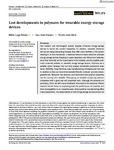Mostrar o rexistro simple do ítem
Last Developments in Polymers for Wearable Energy Storage Devices
| dc.contributor.author | Lage-Rivera, Silvia | |
| dc.contributor.author | Ares-Pernas, Ana | |
| dc.contributor.author | Abad, María-José | |
| dc.date.accessioned | 2022-06-23T11:58:33Z | |
| dc.date.available | 2022-06-23T11:58:33Z | |
| dc.date.issued | 2022-06-25 | |
| dc.identifier.citation | Lage-Rivera S, Ares-Pernas A, Abad M-J. Last developments in polymers for wearable energy storage devices. Int J Energy Res. 2022;46(8):10475‐10498. doi:10.1002/er.7934 | es_ES |
| dc.identifier.issn | 1099-114X | |
| dc.identifier.uri | http://hdl.handle.net/2183/30984 | |
| dc.description | Financiado para publicación en acceso aberto: Universidade da Coruña/CISUG | es_ES |
| dc.description.abstract | [Abstract] Our modern and technological society requests enhanced energy storage devices to tackle the current necessities. In addition, wearable electronic devices are being demanding because they offer many facilities to the person wearing it. In this manuscript, a historical review is made about the available energy storage devices focusing on super-capacitors and lithium-ion batteries, since they currently are the most present in the industry, and the possible polymeric materials suitable on wearable energy storage devices. Polymers are a suitable option because they not only possess remarkable mechanical resistance, flexibility, long life-times, easy manufacturing techniques and low cost in addition to they can be environmentally friendly, nontoxic, and even biodegradable too. Moreover, the electrical and electrochemical polymer properties can be tunning with suitable fillers giving to versatile conducting polymer composites with a good cost and properties' ratio. Although the advances are promising, there are still many drawbacks that need to be overcome. Future research should focus on improving both the performance of materials and their processability on an industrial scale, where additive manufacturing offers many possibilities. The sustainability of new energy storage devices should not be forgotten, encouraging the use of more environmentally friendly materials and manufacturing processes. | es_ES |
| dc.description.sponsorship | The authors thank the financial support from Ministerio de Ciencia e Innovation/FEDER (project ref; PID2020-116976RB-I00) and Xunta de Galicia-FEDER (Program of Consolidation and structuring competitive research units [ED431C 2019/17]). Funding for open access charge from Universidade da Coruña/CISUG | es_ES |
| dc.description.sponsorship | Xunta de Galicia; ED431C 2019/17 | es_ES |
| dc.language.iso | eng | es_ES |
| dc.publisher | Wiley | es_ES |
| dc.relation | info:eu-repo/grantAgreement/AEI/Plan Estatal de Investigación Científica y Técnica y de Innovación 2017-2020/PID2020-116976RB-I00/ES/REVALORIZACION DE LIGNINA EN COMPUESTOS POLIMERICOS CONDUCTORES PARA IMPRESION 3D/ | |
| dc.relation.uri | https://doi.org/10.1002/er.7934 | es_ES |
| dc.rights | Attribution-NonCommercial-NoDerivatives 4.0 International (CC BY-NC-ND 4.0) | es_ES |
| dc.rights.uri | https://creativecommons.org/licenses/by-nc-nd/4.0/ | * |
| dc.subject | Batteries | es_ES |
| dc.subject | Energy storage | es_ES |
| dc.subject | Polymer composites | es_ES |
| dc.subject | Super-capacitors | es_ES |
| dc.subject | Wearable | es_ES |
| dc.title | Last Developments in Polymers for Wearable Energy Storage Devices | es_ES |
| dc.type | info:eu-repo/semantics/article | es_ES |
| dc.rights.access | info:eu-repo/semantics/openAccess | es_ES |
| UDC.journalTitle | International Journal of Energy Research | es_ES |
| UDC.volume | 46 | es_ES |
| UDC.issue | 8 | es_ES |
| UDC.startPage | 10475 | es_ES |
| UDC.endPage | 10498 | es_ES |
| dc.identifier.doi | 10.1002/er.7934 |






